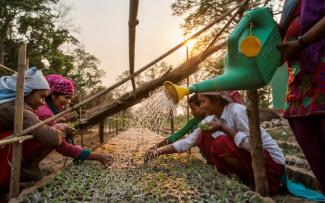Nepal hosts some of the most spectacular natural areas and biodiversity in the world. Home to the planet’s highest peak, Nepal also boasts 118 ecosystems, 75 categories of vegetation, and 35 types of forest. These resources are increasingly at risk. The people of Nepal, particularly the rural poor, are directly dependent on natural resources for survival, and a significant portion of Nepal’s economy comes from climate-sensitive industries such as agriculture, forestry, and eco-tourism. Nepal is one of the most disaster-prone countries in the world and, aside from earthquakes, all of the major disaster risks it faces are linked to the climate. Climate-related disasters already exact costs equivalent to approximately 1.5% of GDP per year, a figure likely to grow as extreme weather events become more frequent and severe.
Long recognized by the U. S. Government as a priority country for biodiversity conservation, USAID is reducing the adverse impacts of climate change and threats to biodiversity in Nepal. Building on a successful community forestry program that engages 35 percent of Nepal’s total population, USAID strengthens the ability of local communities to take ownership of their resources and manage them according to international standards. USAID also helps local governments to develop plans to overcome or adapt to climate change risks.
In 2016, USAID worked with the Government of Nepal, law enforcement agencies, and local communities to protect nearly 6 million hectares of forest and collaboratively manage natural resources in these areas. USAID programs have also helped contribute to a 20 percent increase in the rhino population since 2011, and a 30 percent increase in Nepal’s tiger population since 2009.

USAID Hariyo Ban II Project/WWF
